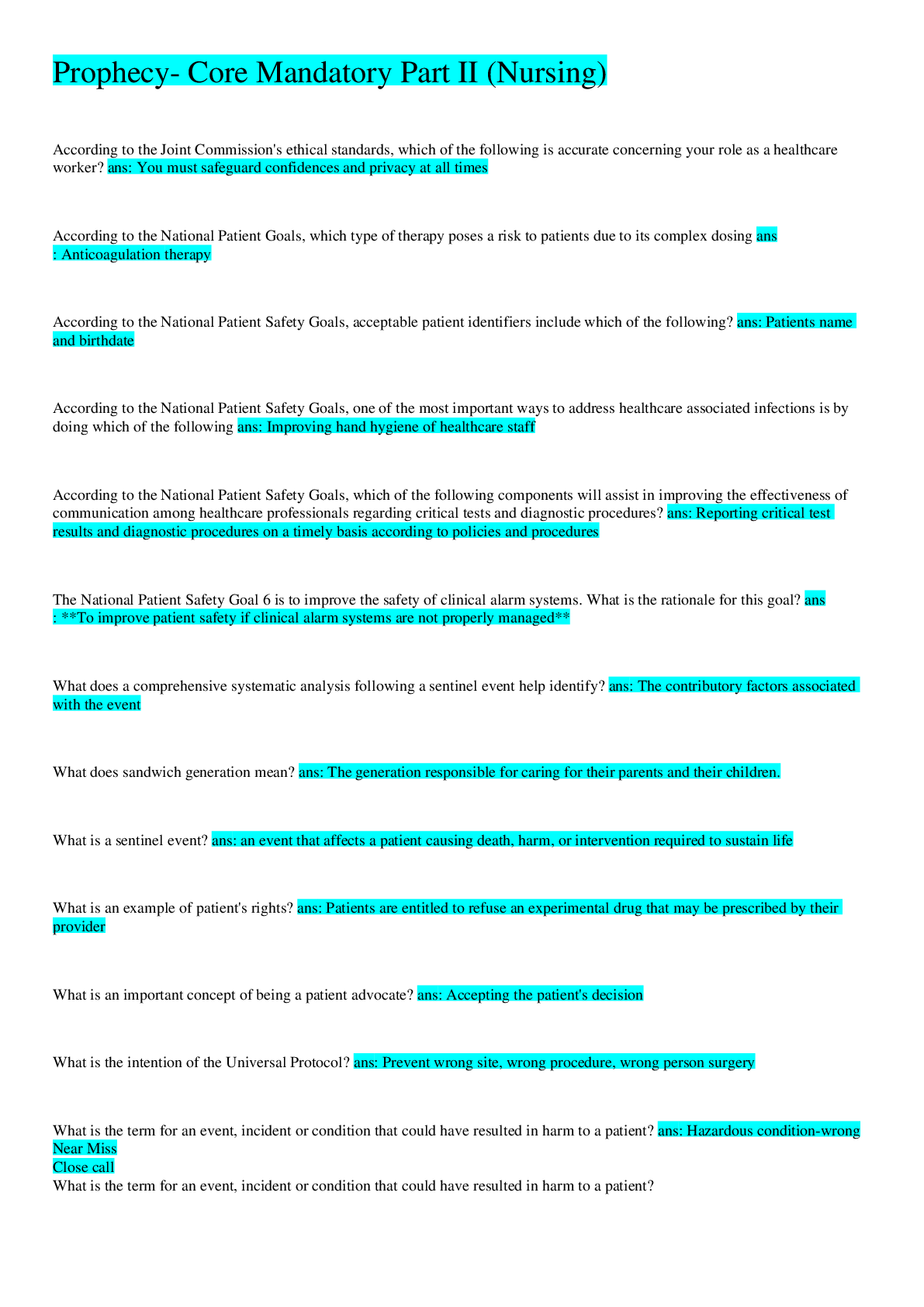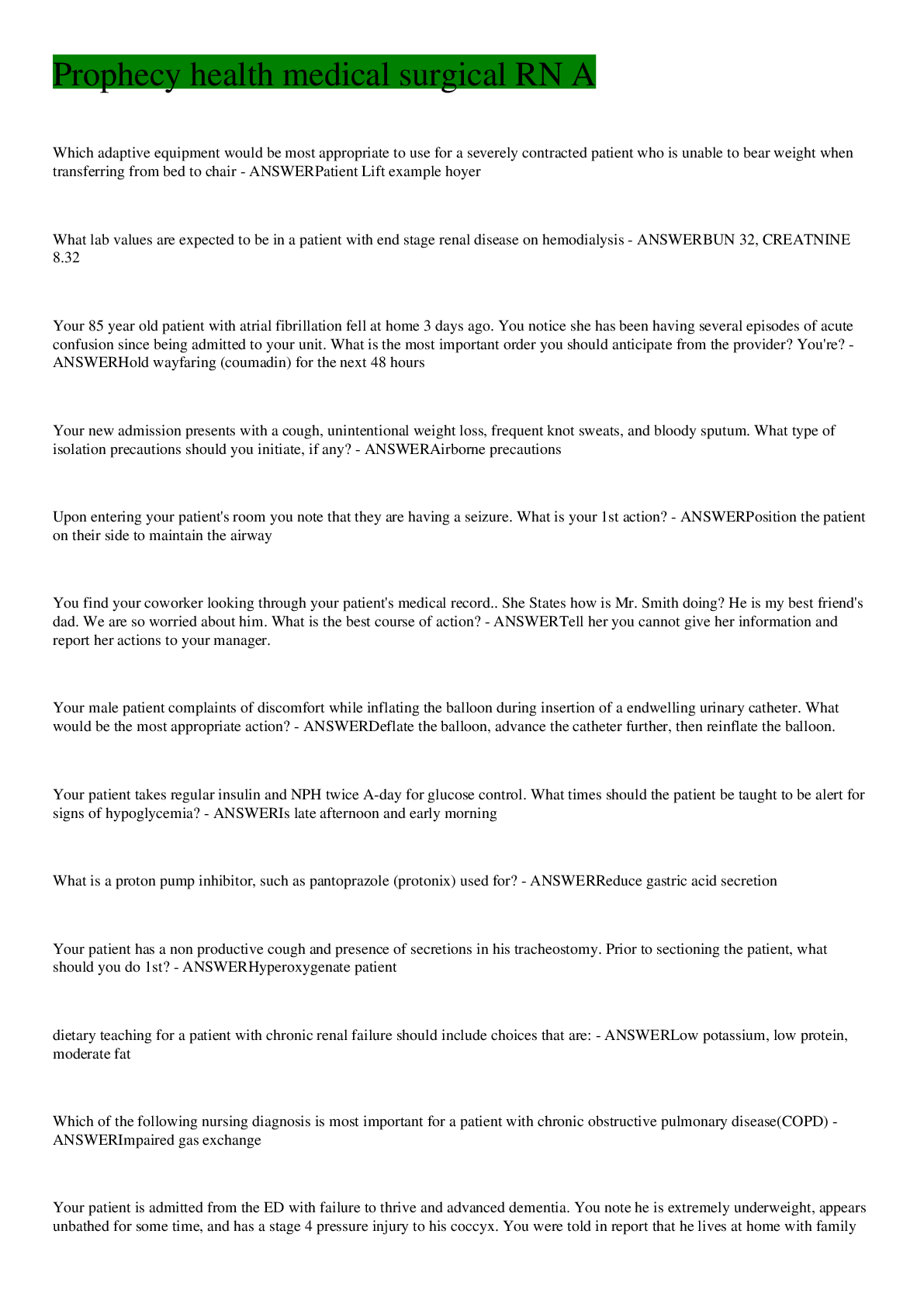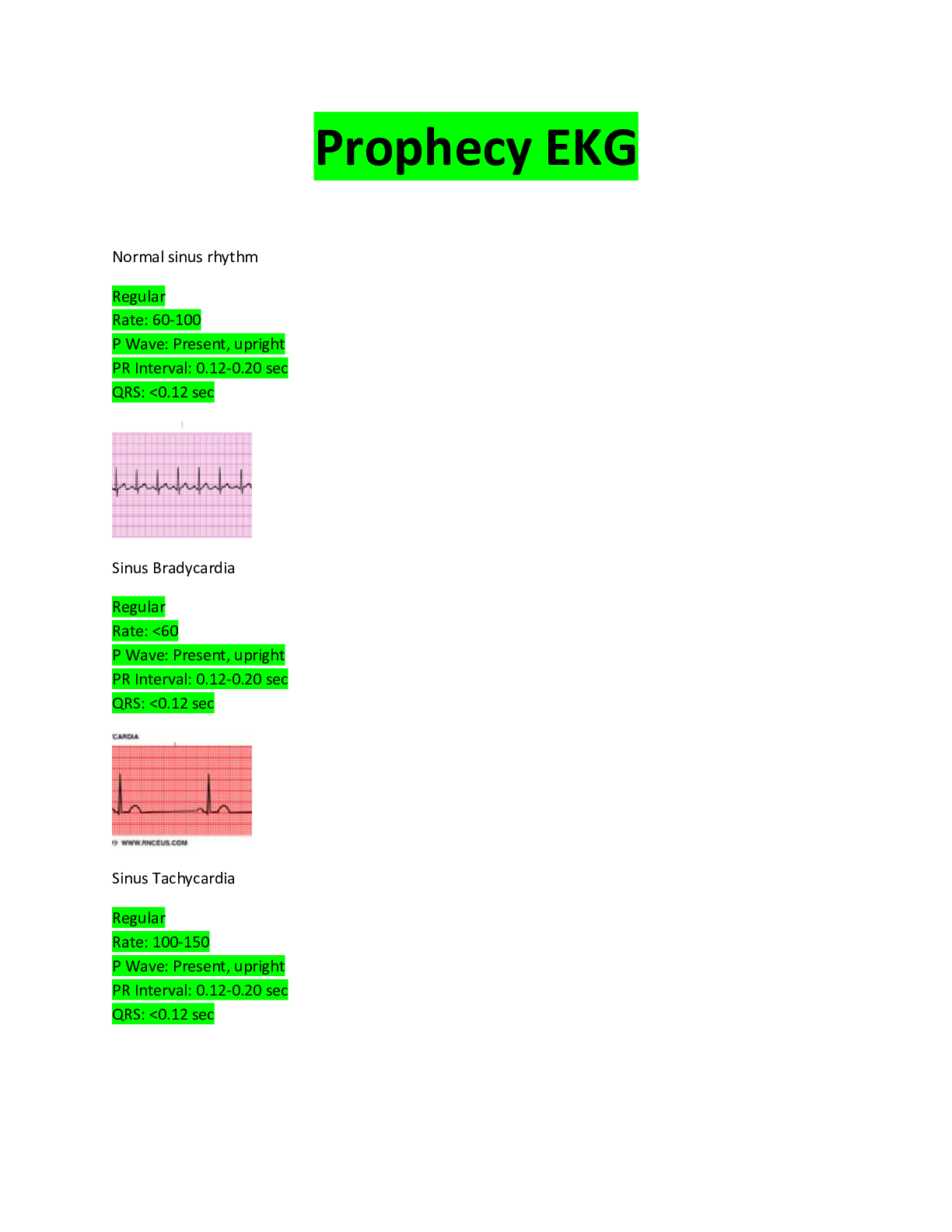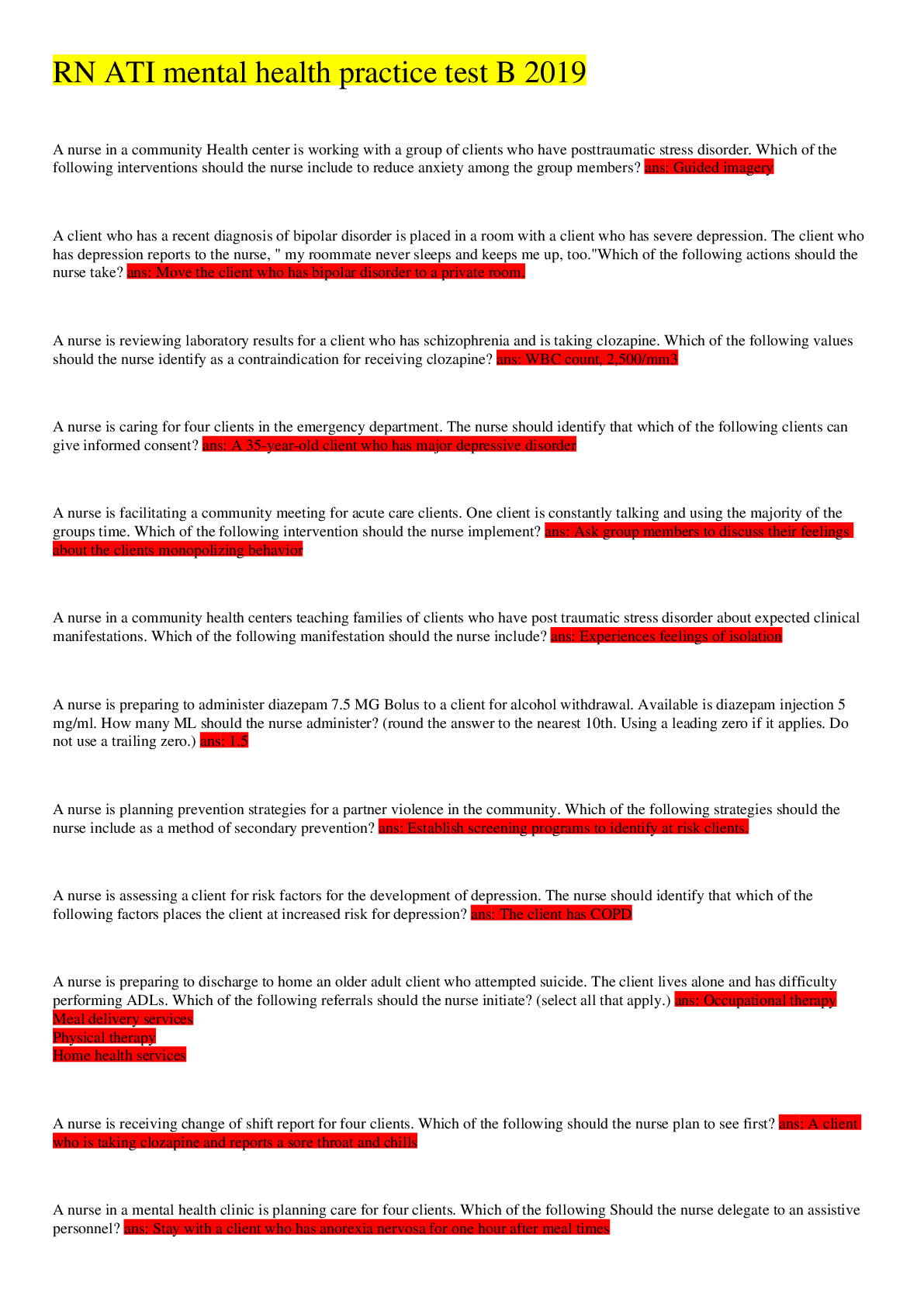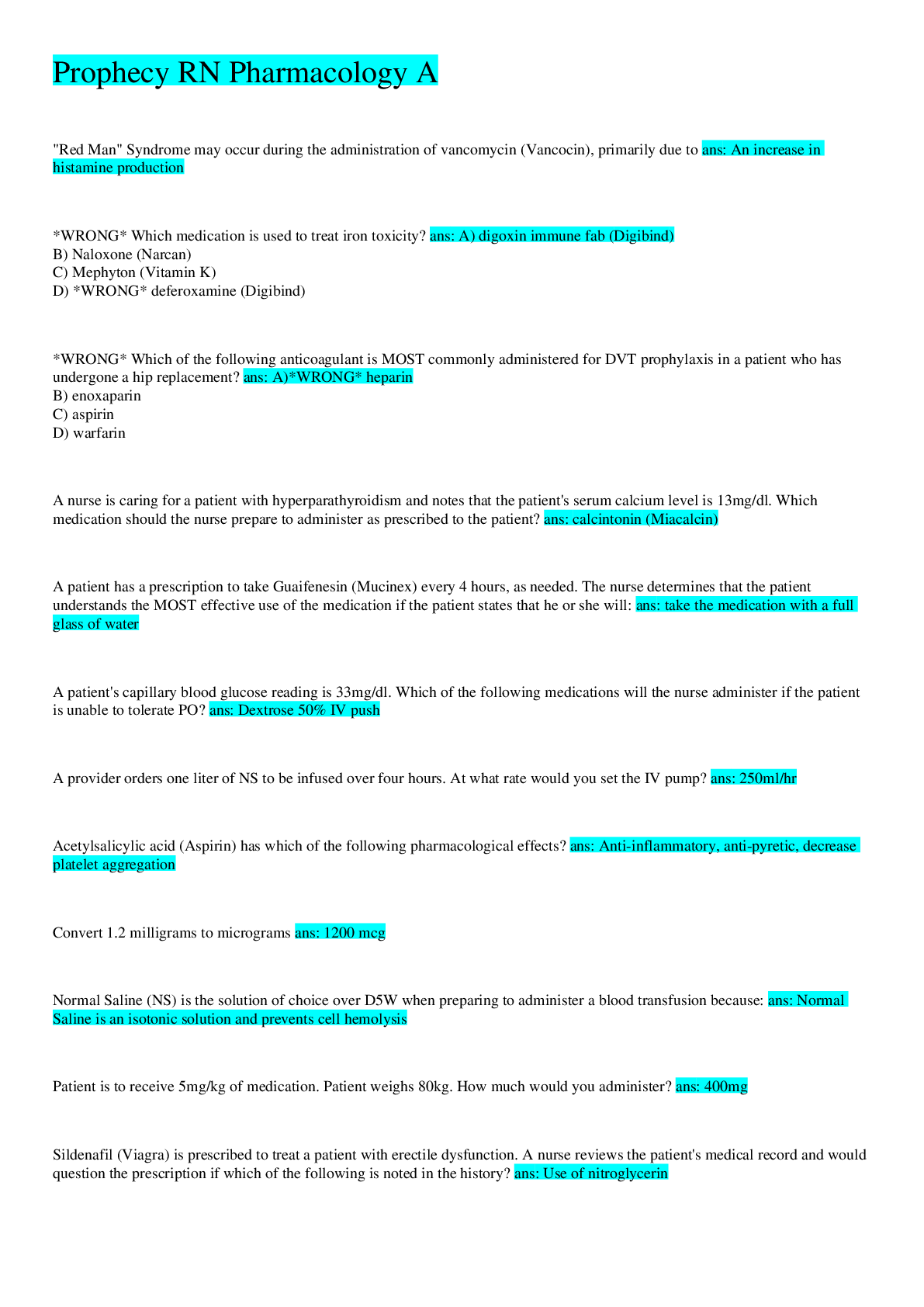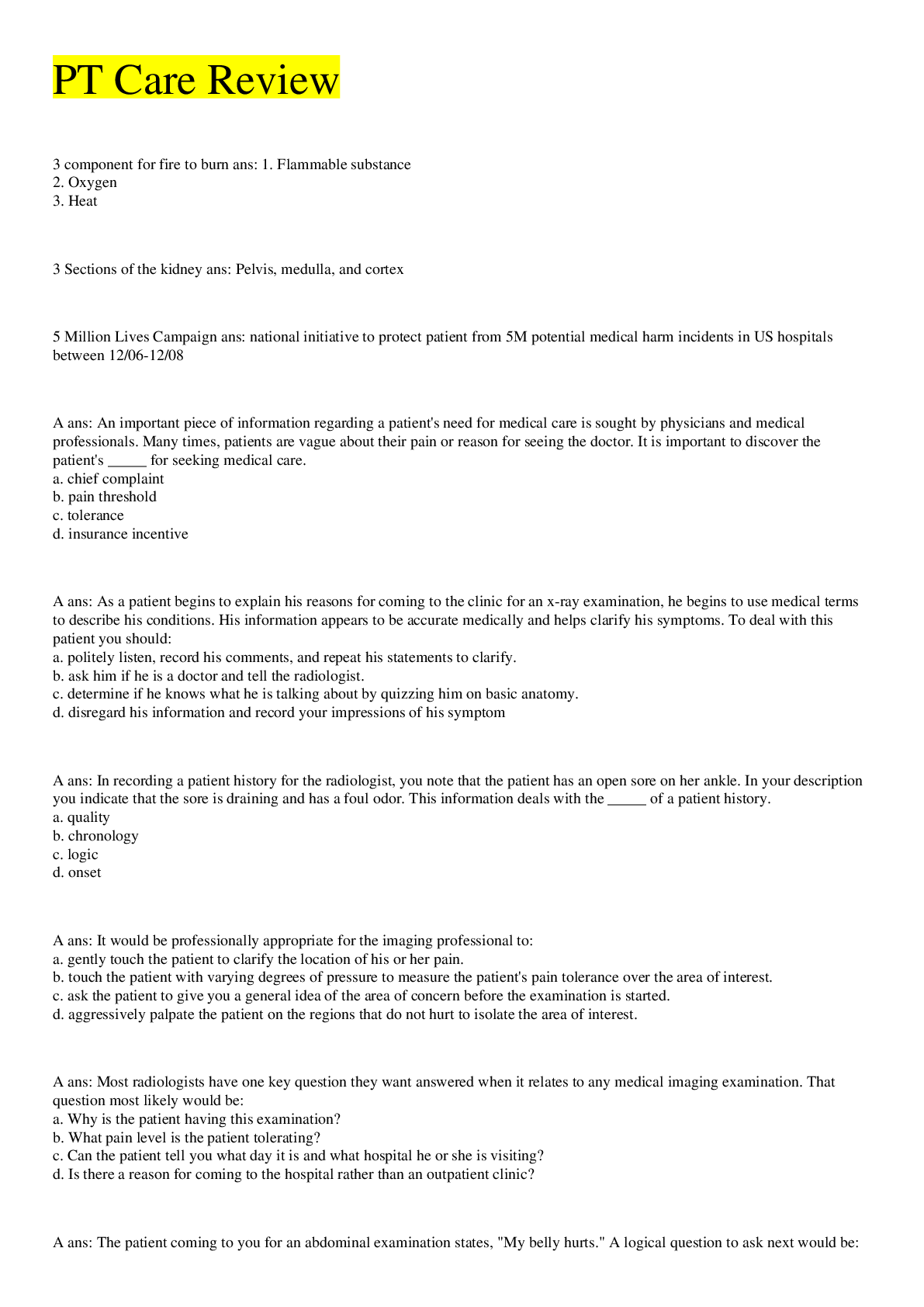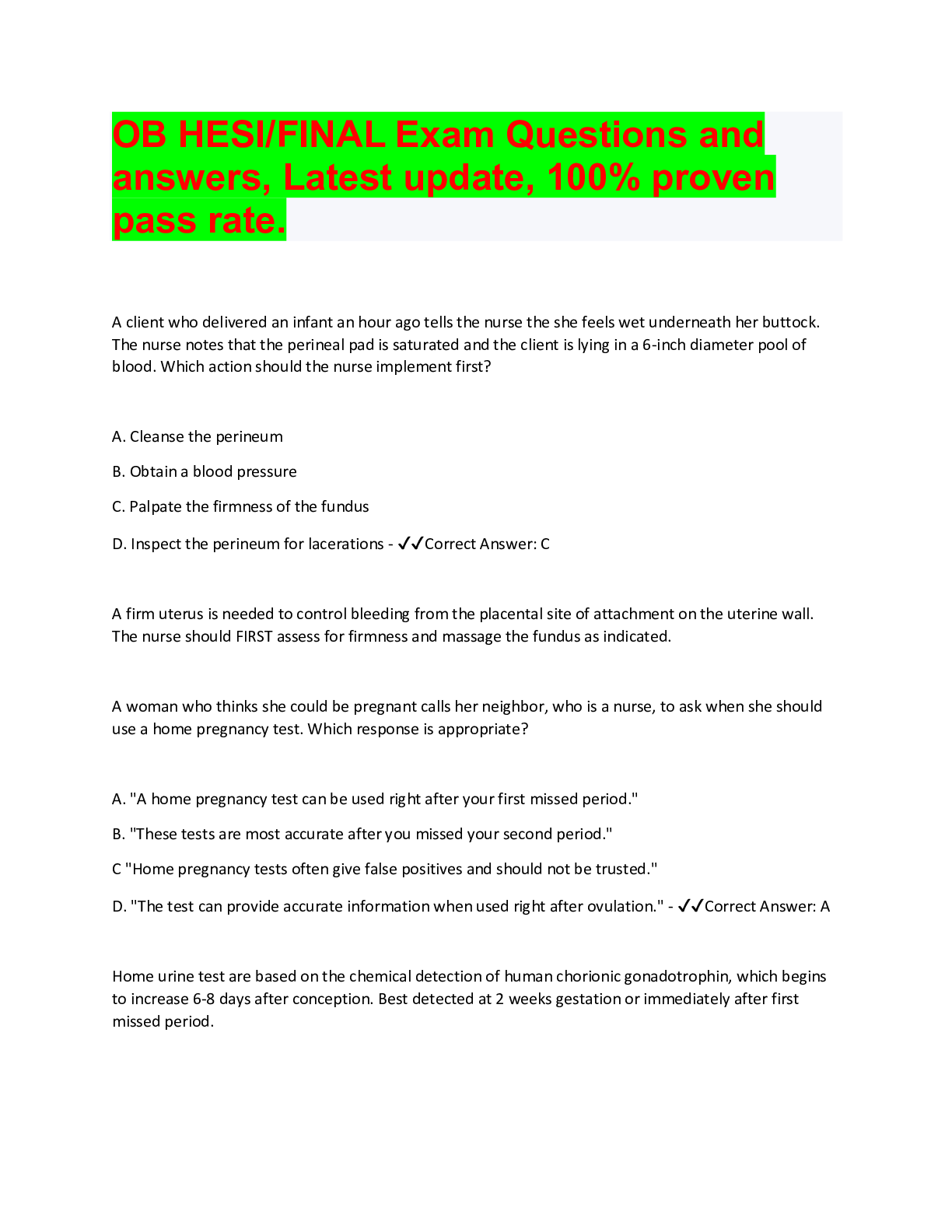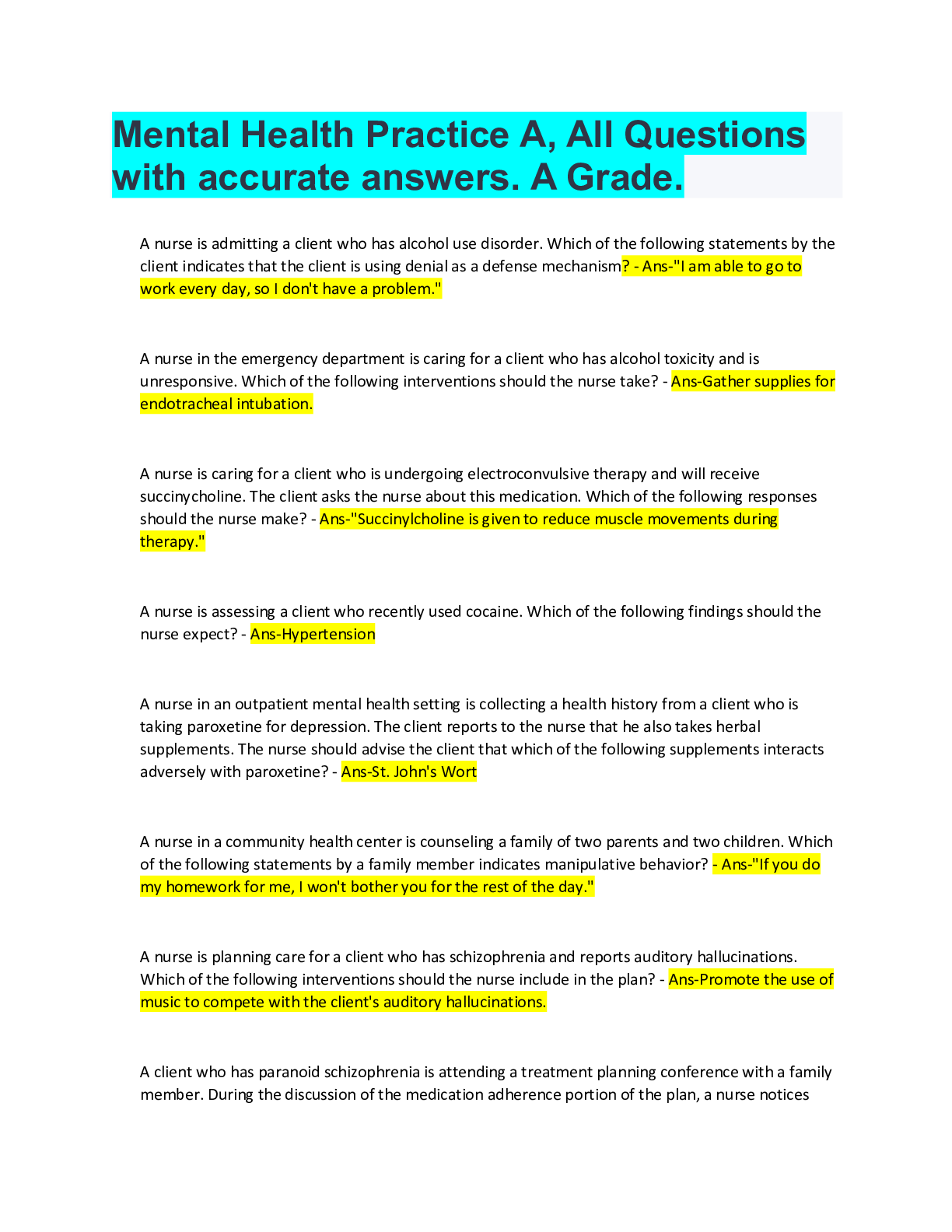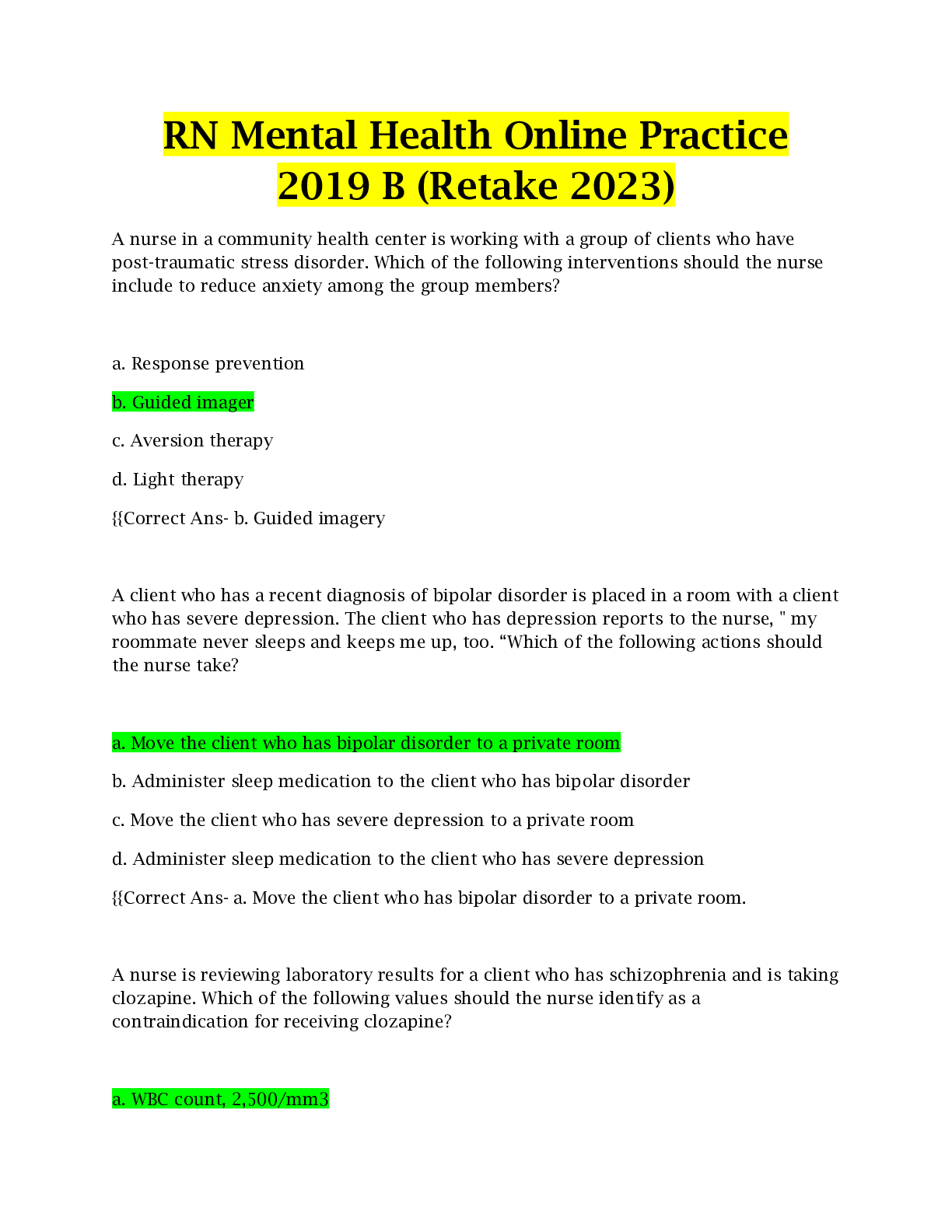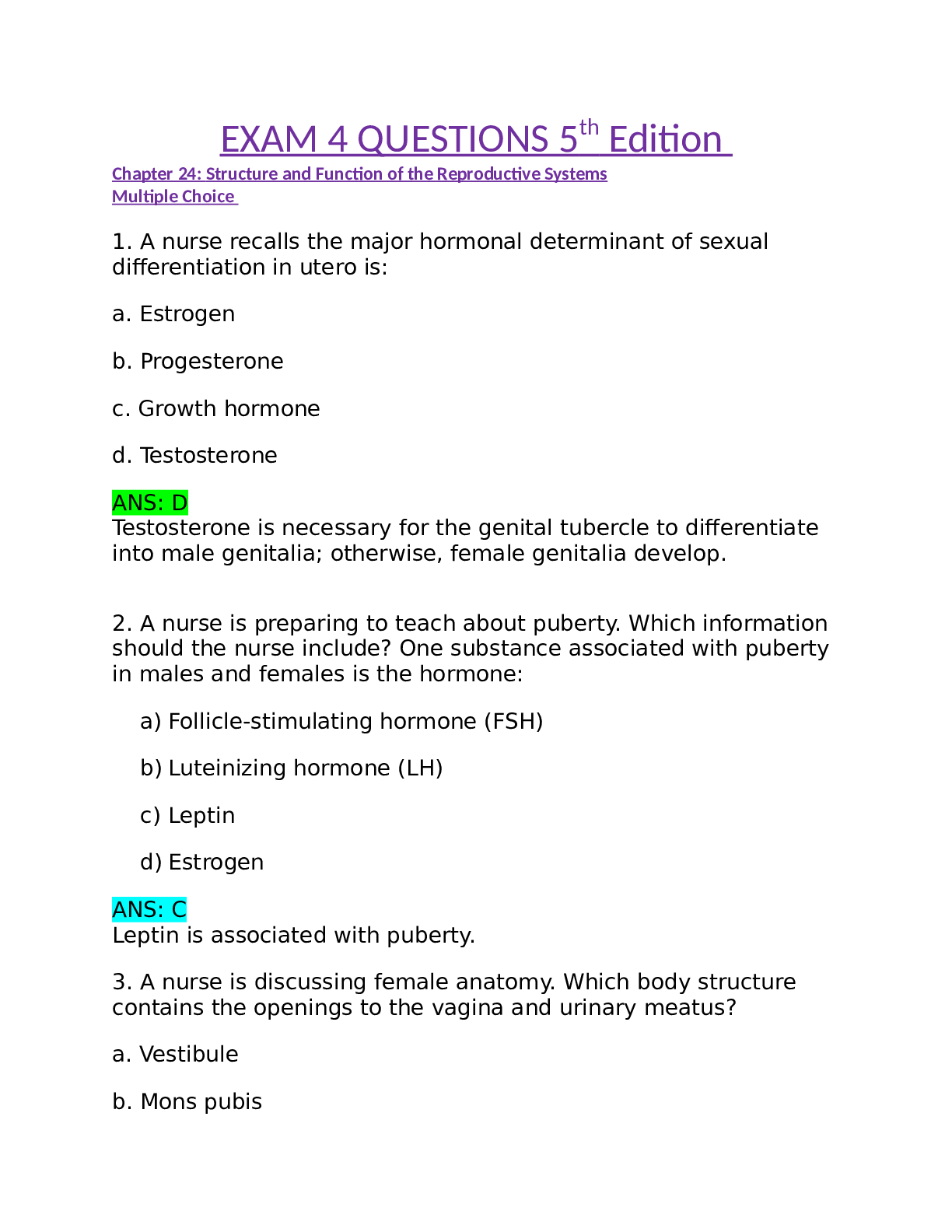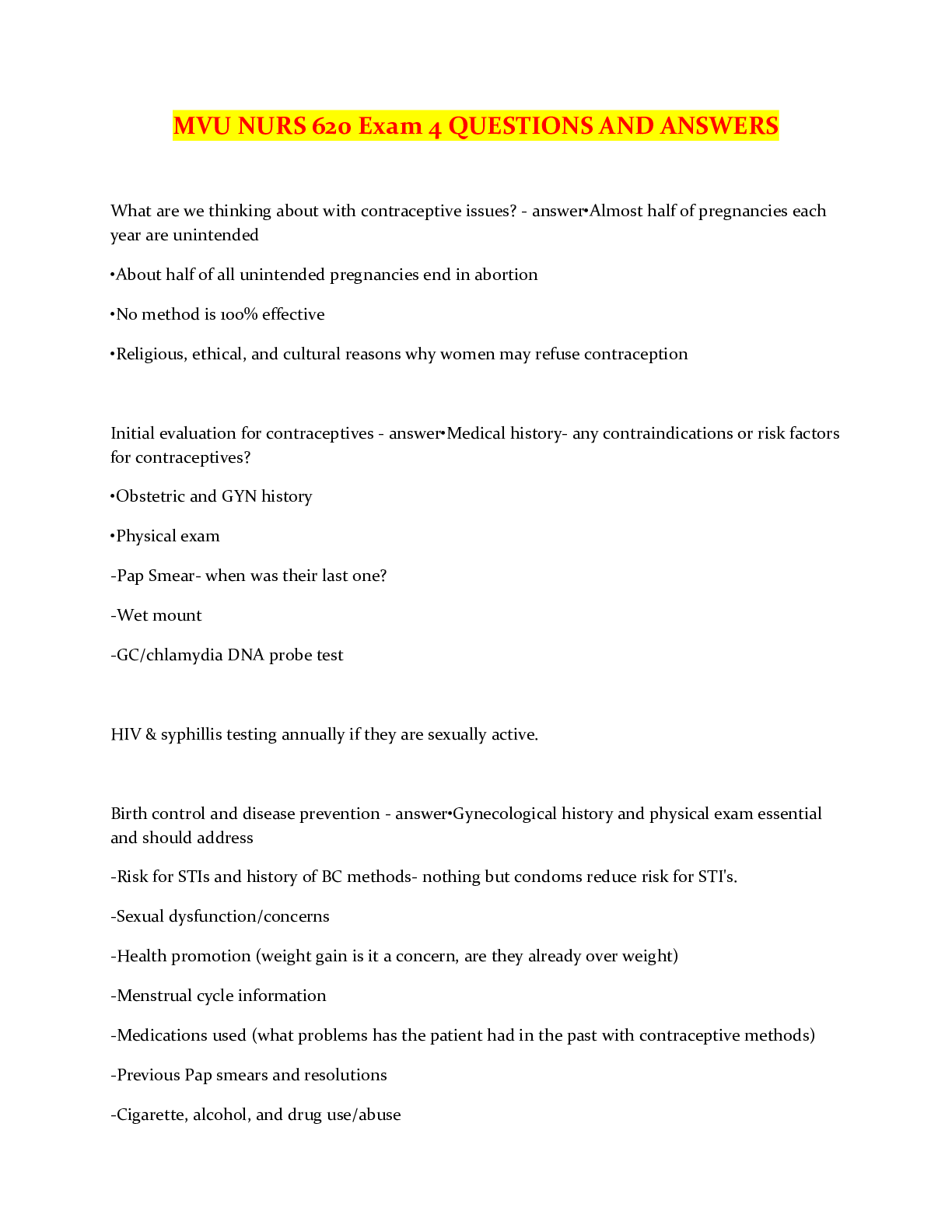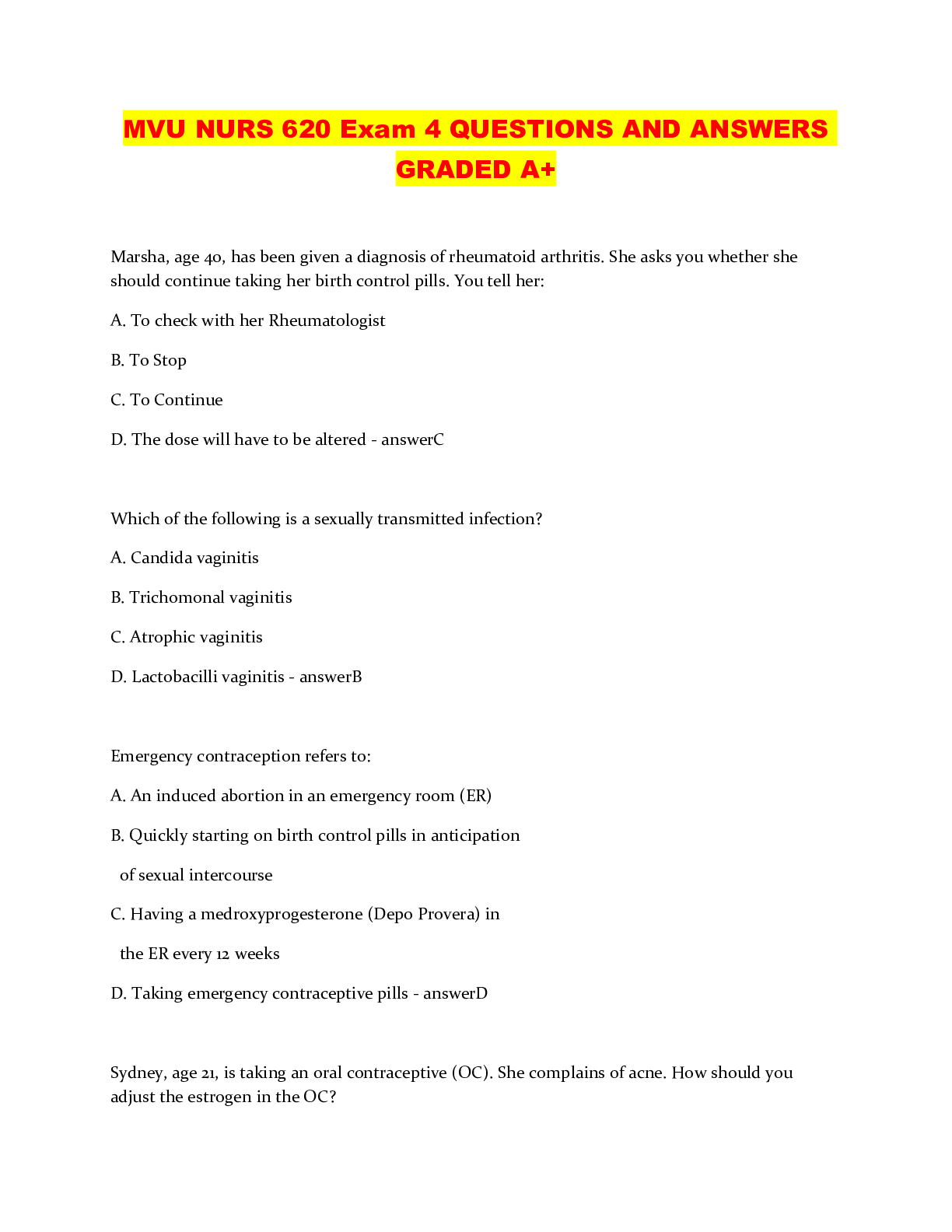Biology > QUESTIONS & ANSWERS > NURS 629 exam 4 QUESTIONS AND ANSWERS (All)
NURS 629 exam 4 QUESTIONS AND ANSWERS
Document Content and Description Below
NURS 629 exam 4 Rovsing sign ans: apply pressure to lower left abdomen. Pain felt on right side of abdomen when pressure released. + Ant/ Post Drawer sign ans: assess for injury of ant/post cruc... iate ligament Osgood- Schlatter disease ans: most common in later childhood and early adolescence. Painful swelling and tenderness of tibial tuberosity. Most common in children in sports. *initial TX is stretching. TX for sprained ankle ans: apply cold for 20 min, off for 20-45 min. Repeat 1st 24-48hrs. Rest, elevate, compress (RICE) Legg-calve perthes ans: idiopathic osteonecrosis of femoral head. 4x more common in males. Hip pain, knee pain, painless limp that is worse at end of day. Frog leg xray best to diagnose. Viral gastroenteritis ans: Most common complication is dehydration.Tx is small, frequent amounts of oral rehydration solution. BG for 4y/o ans: goal of 90-130 Suspected growth hormone deficiency ans: short, slow growth. Childlike faces with prominent forehead. *Initial eval include TSH, BG (hypoglycemia), GI illness, CBC, sed rate, UA, growth factor. Initial eval in cases of isolated menarche ans: *sexual abuse should be ruled out first essentials for childs mental health ans: predictable home, childcare, school routines Migraine ans: unilateral, pulsating, occasional photophobia. Iron deficiency anemia ans: *Microcytic, hypochromic. Most common cause is poor dietary intake/ breastfeeding risk. Prevalence is 25% of children between ages 10-15 mos. Depression Comorbidities ans: anxiety disorder, mixed anxiety/depression. ADHD, conduct/learning/oppositional defiant disorders. SAD, eating disorders, stress. Depression risk factors ans: attention, conduct, learning disorders. Chronic illness (diabetes). abuse/neglect. other trauma or natural disasters. *Separation anxiety. PHQ9 ans: depression screening tool for ages 11 and up signs of PTSD ans: re-experiencing trauma thru intrusive distressing recollections of event, flashbacks, nightmares. Avoidance of places, people, and activities that are reminders of trauma, and emotional numbness. Increased arousal such as difficulty sleeping and concentrating, feeling jumpy, easily irritated and angered. *Extreme temper tantrums in preschool aged kids. slipped capital femoral epiphysis risk factors ans: Obesity, males, sports, femoral retroversion, hypothyroidism, avg age presentation is 12y/o for females and 13y/o for males. slipped capital femoral epiphysis clinical findings: ans: limping, knee/hip pain, pain worse with activity, localized pain to ant thigh or knee. May be unable to bear wt all together, loss of internal rotation of hip with flexion, affected extremity is usually shorter. Loss of abduction and extension slipped capital femoral epiphysis DX and TX ans: -xray. Always refer to peds ortho. Keep non wt bearing until surgical eval. Scoliosis ans: most common type is idiopathic. *In order to confirm suspected, get AP and lateral standing Xray view of spine Bactrim ans: treatment of choice for UTI in children TX for gastroenteritis ans: small, frequent amounts of oral rehydration solution Appendicits ans: Constant periumbilical pain shifting to RLQ. Worsens over period of 4hrs. Pain subsides as it migrates to RLQ and then worsens with movement, deep respir, and coughing.Pain/Fever are late sign, leading to perforation. Vomiting. *Elevated WBC. Neural mediated syncope ans: most common form of fainting/ frequent ED visits. Happens in part of nervous system that regulates BP. Place pt reclining position to restore blood flow/ consciousness. Situational syncope, vasovagal, reflex, neurocardiogenic part of it. Residual findings are pallor, fatigue, diaphoresis Cardiac syncope ans: causes: bradycardia, tachycardia, hypotension, exercise triggered. Palpitations. Residual findings: incontinence, disorientation, or injury. Goiter ans: commonly found on exam with hyperthyroidism DM1 treatment goals ans: achieve normal growth/development. Achieve optimal glycemic control. + psychosocial adjustment to diabetes. Hgb A1C < 7.5 DM managament ans: DM1= start on insulin. Check BG 6-10x/day. Monitor urine/ blood for ketones in prolonged hyperglycemia. Exercise moderate-vigorous & bone strengthening 3x/week. BG goal during exercise 90-250 and have carbs available. DM eye exams ans: at 10y/o or puberty and on, initial dilated and comprehensive eye exam after having DM for 3-5 yrs. F/u recommended in opthamol Q2 years pending risk level E coli ans: most common cause of UTI in children Red flags for sensory processing disorder ans: overly sensitive to touch, noise, smell; poor self-esteem; afraid of failing at new tasks; lethargic and slow; always on go; impulsive; distractible/leaves tasks uncompleted; clumsy, slow, poor motor skills/ handwriting. signs of normal cognition development in toddlers: ans: emerging empathy, understanding social rules, constructing narratives, reciprocity in play. executive functions required for self-regulation ans: Inhibition, Flexibility, Emotional control Education for febrile seizures ans: Not actual seizure; best prevention is tylenol/ ibuprofen alternate Q4hr; hydrate & rest; seek emergency care if seizure lasting longer than 5 minutes Mgmt & TX reflux ans: Keep breastfeeding; formula fed= 2 week trial of extensively hydrolyzed formula or amino acid based to exclude CMA and thicken formula. screening with known risk factors for DM2 recommended at 10y/o onset of puberty and repeat= ans: every other year increased risk of DM ans: impaired fasting BG (>100 but <125); impaired glucose tol (2hr post prandial 140-199) rates of UTI among uncircumcised infant boys are much higher than circumcised by ans: as much as 20% most likely to be presentation of UTI in 20 month old? ans: Fever ideal method for obtaining urine sample for culture in 18 month female with suspected uti? ans: suprapubic aspiration UA of 10 month old with UTI, NP knows ans: 20% of UA can be normal child 2 months- 2 years with UTI, antibiotic therapy for ans: 7-14 days 12 month old with fever, suspected UTI, vomited 5x in last 7hours, last wet diaper ~6hrs ago. Prepare to ans: arrange for child to be admitted to hospt preferred urinary tract imaging for 22 month old with 1st time febrile UTI ans: Renal bladder ultrasound (RBUS) most compelling reason to get RBUS instead of voiding cystogram (VCUG)? ans: noninvasive test VCUG indicated ans: if UTI recurrent rehydrate child with moderate dehydration with ans: oral rehydration. as effective as IV fluid and less costly when considering antidiarrheals and antimotility in young children with gastroenteritis, NP knows ans: these agents should be avoided. most common cause of viral gastroenteritis ans: Norovirus to obtain most accurate hydration status, ask about ans: time of last urination [Show More]
Last updated: 1 year ago
Preview 1 out of 5 pages
Instant download
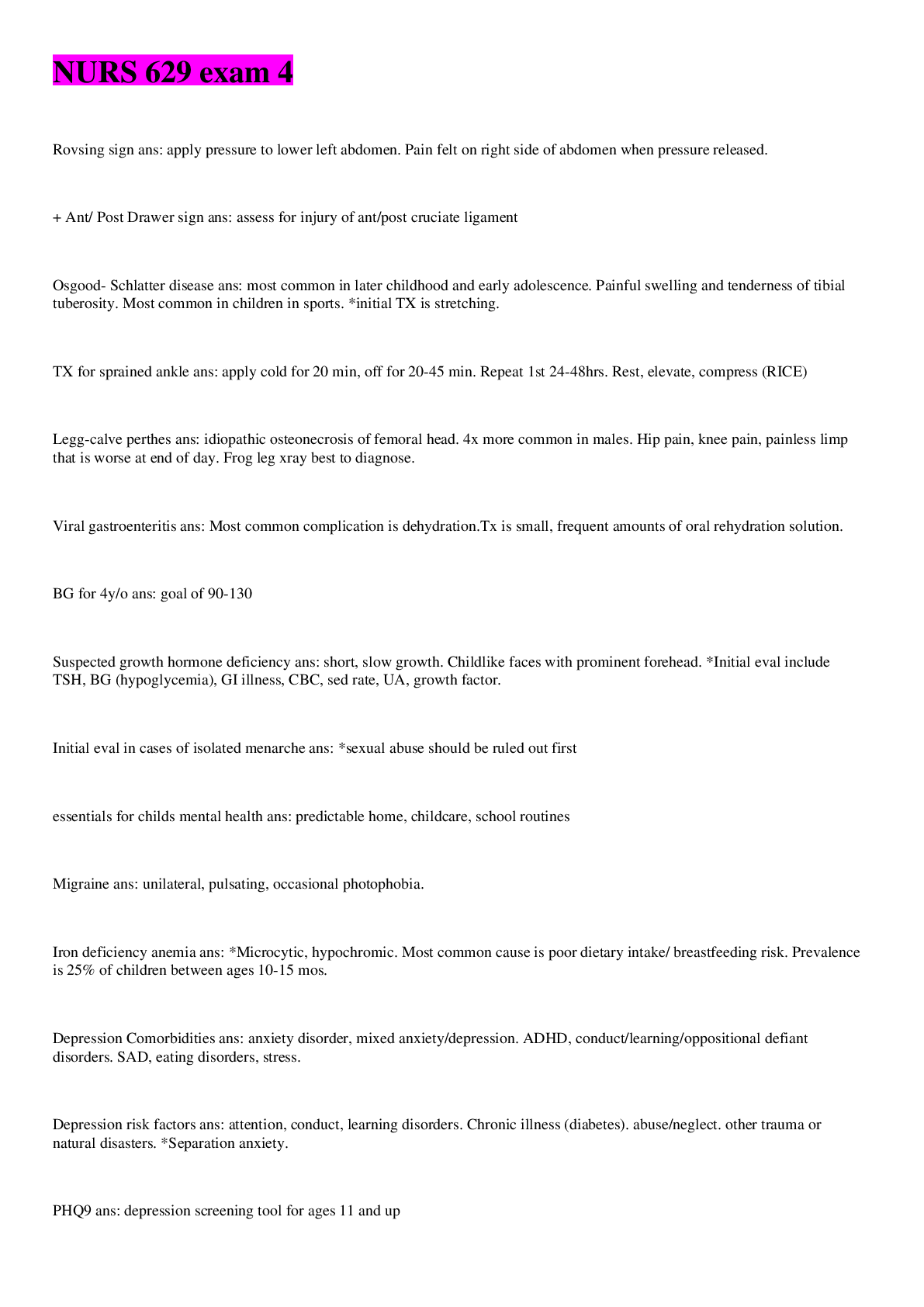
Buy this document to get the full access instantly
Instant Download Access after purchase
Add to cartInstant download
Reviews( 0 )
Document information
Connected school, study & course
About the document
Uploaded On
May 23, 2022
Number of pages
5
Written in
Additional information
This document has been written for:
Uploaded
May 23, 2022
Downloads
0
Views
33


